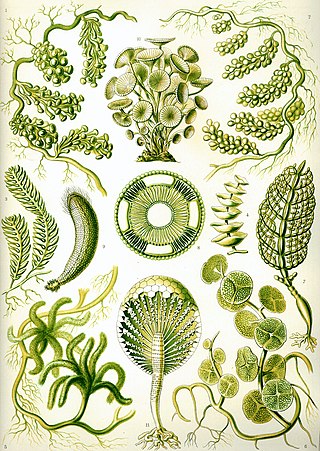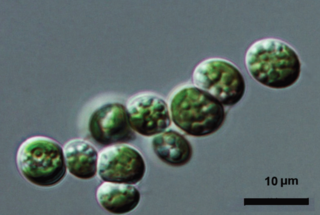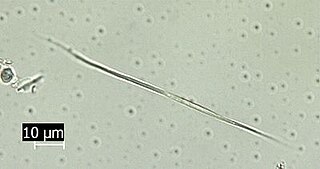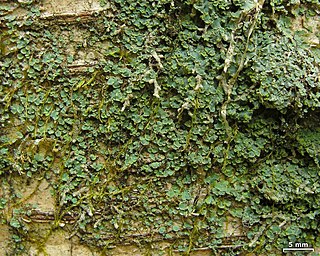
The Chlorophyceae are one of the classes of green algae, distinguished mainly on the basis of ultrastructural morphology. They are usually green due to the dominance of pigments chlorophyll a and chlorophyll b. The chloroplast may be discoid, plate-like, reticulate, cup-shaped, spiral- or ribbon-shaped in different species. Most of the members have one or more storage bodies called pyrenoids located in the chloroplast. Pyrenoids contain protein besides starch. Some green algae may store food in the form of oil droplets. They usually have a cell wall made up of an inner layer of cellulose and outer layer of pectose.

Chlorophyta is a division of green algae informally called chlorophytes.

The Trebouxiophyceae, also known as trebouxiophytes, are a class of green algae, in the division Chlorophyta. Members of this class are single-celled, colonial, or multicellular and are found in freshwater or terrestrial habitats worldwide. Many taxa in the Trebouxiophyceae form symbiotic relationships with other organisms; in particular, the majority of phycobionts within lichens are trebouxiophytes. A number of taxa have also lost the ability to photosynthesize, and have evolved to become parasitic; examples include Prototheca and Helicosporidium.

Selenastraceae is a family of green algae in the order Sphaeropleales. Members of this family are common components of the phytoplankton in freshwater habitats worldwide. A few species have been found in brackish and marine habitats, such as in the Baltic Sea.
Desmococcus is a genus of green algae in the family Stichococcaceae. It is a subaerial genus of algae with a cosmopolitan distribution.
Dictyochloris is a genus of green algae in the class Chlorophyceae. It is the sole genus of the family Dictyochloridaceae. It is commonly found in terrestrial and subaerial habitats.
Dictyochloropsis is a genus of unicellular green alga of the phylum Chlorophyta. This genus consists of free-living algae which have a reticulate (net-like) chloroplast that varies slightly in morphology between species, and that when mature always lacks a pyrenoid. Dictyochloropsis is asexual and reproduces using autospores.

Elliptochloris is a genus of green algae in the order Prasiolales. Species of this genus are common and found in a variety of terrestrial habitats such as soils. Some species in the genus are photobiont partners in lichens. One species, E. marina, is a symbiont within two species of sea anemone, Anthopleura elegantissima and A. xanthogrammica. It seems to have a worldwide distribution.

Geminella is a genus of green algae in the phylum Chlorophyta. Once considered part of the order Ulotrichales, molecular phylogenetics have shown that Geminella and related genera form a well-supported clade within the class Trebouxiophyceae.

Trebouxia is a unicellular green alga. It is a photosynthetic organism that can exist in almost all habitats found in polar, tropical, and temperate regions. It can either exist in a symbiotic relationship with fungi in the form of lichen or it can survive independently as a free-living organism alone or in colonies. Trebouxia is the most common photobiont in extant lichens. It is a primary producer of marine, freshwater and terrestrial ecosystems. It uses carotenoids and chlorophyll a and b to harvest energy from the sun and provide nutrients to various animals and insects.
Symbiochloris reticulata is a species of green alga in the Trebouxiales. It is a known as a photobiont with several lichen species, like Lobaria pulmonaria, but also as a free-living soil alga as well. Phylogenetic analysis of rRNA sequence data revealed that the species shares a sister group relationship with two other green algae that lack motile stages, Chlorella saccharophila and C. luteoviridis.

Lichen anatomy and physiology is very different from the anatomy and physiology of the fungus and/or algae and/or cyanobacteria that make up the lichen when growing apart from the lichen, either naturally, or in culture. The fungal partner is called the mycobiont. The photosynthetic partner, algae or cyanobacteria, is called the photobiont. The body of a lichens that does not contain reproductive parts of the fungus is called the thallus. The thallus is different from those of either the fungus or alga growing separately. The fungus surrounds the algal cells, often enclosing them within complex fungal tissues unique to lichen associations. In many species the fungus penetrates the algal cell wall, forming penetration pegs or haustoria similar to those produced by pathogenic fungi. Lichens are capable of surviving extremely low levels of water content (poikilohydric). However, the re-configuration of membranes following a period of dehydration requires several minutes at least.

Koliellaceae is a family of green algae in the order Prasiolales.
Elisabeth Tschermak-Woess was an Austrian University lecturer, cytologist, and phycologist who worked with lichen photobionts. In 1994, Tschermak-Woess was awarded the Acharius Medal for her lifetime contributions to lichenology. She had a Festschrift dedicated to her in 1988, in the journal Plant Systematics and Evolution. Lichen taxa that have been named after Tschermak-Woess include the genus Woessia and the species Asterochloris woessiae.
Trebouxia decolorans is a widespread and common symbiotic species of green alga that is found in association with different species of lichen-forming fungi. Some lichens in which it is the photobiont partner are Xanthoria parietina and Anaptychia ciliaris.
Trebouxia gelatinosa is a common symbiotic species of green alga in the family Trebouxiaceae. Formally described as new to science in 1975, it is usually found in association with different species of lichen-forming fungi.
Asterochloris italiana is a species of green alga in the family Trebouxiaceae. It was first formally described by the phycologist Patricia A. Archibald in 1975, as a species of Trebouxia. It was transferred to the genus Asterochloris in 2010.

Normandina pulchella, commonly known as the elf-ear lichen or blue heart, is a species of squamulose lichen in the family Verrucariaceae. This cosmopolitan species is widely distributed across both hemispheres, where it thrives in moist microhabitats. It favours moss-covered deciduous trees and rocks, often colonising over mosses and bryophytes. It occasionally grows on bare bark and on other lichens. Distinctive features of N. pulchella include its bluish-green squamules (scales) with sharply raised margins, non-reactivity to standard chemical spot tests, and growth in humid habitats. Initially, Nannochloris normandinae, a green alga, was thought to be its photobiont. More recent studies, however, have revised this understanding, with Diplosphaera chodatii now recognised as the algal partner.

Elliptochloris bilobata is a species of green alga in the order Prasiolales. First described in 1980, it is the type species of the genus Elliptochloris. The microscopic alga has distinctive ellipsoid cells containing a unique bilobed chloroplast, and reproduces both through autospores and rod-shaped spores. Though originally discovered as a photobiont within the lichen Catolechia wahlenbergii in the Austrian Alps, it has since been found living freely across Europe, Israel, and Antarctica. The species grows on various surfaces including soil, rock, and tree bark, and is known for its ability to grow in both natural and human-modified environments.
Trebouxia flava is a species of green alga in the family Trebouxiaceae. First described in 1975 by Patricia Ann Archibald, it features spherical cells containing multiple nuclei and a single chloroplast with a small pyrenoid. The species is characterized by its distinctive dull-shiny, sulphurous yellow cultures, which differ from the typical shiny yellow-green appearance of most other Trebouxia species. It can reproduce both through motile zoospores and non-motile aplanospores, and was originally isolated from the foliose lichen species Physconia pulverulenta.









